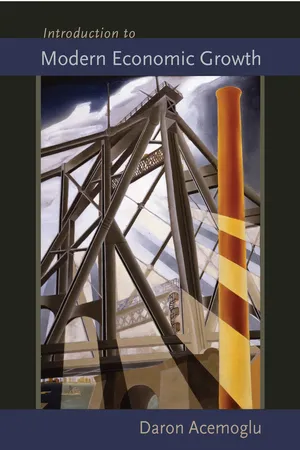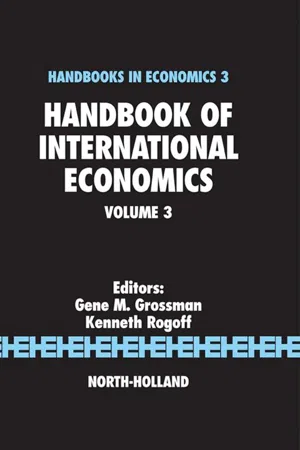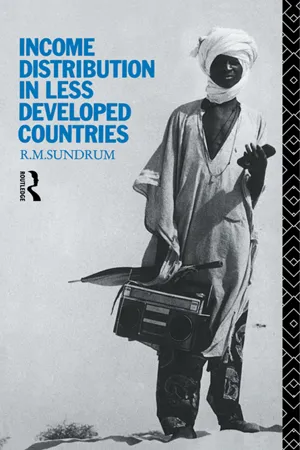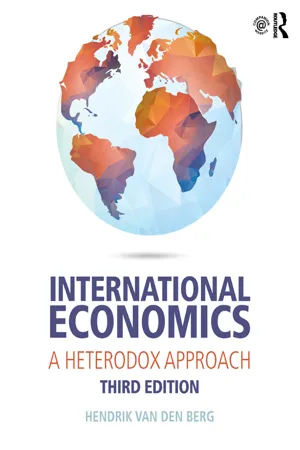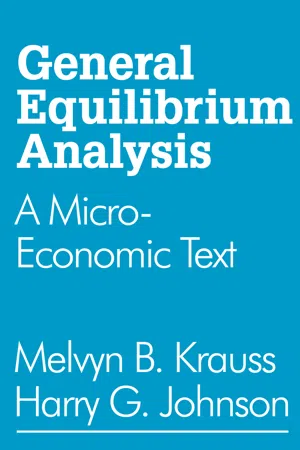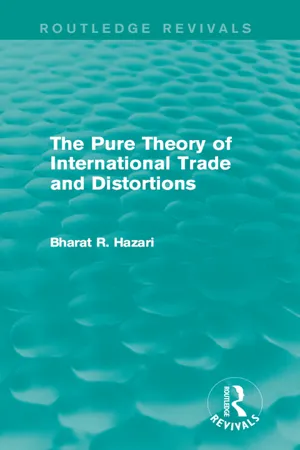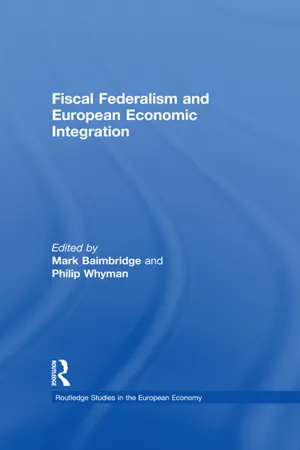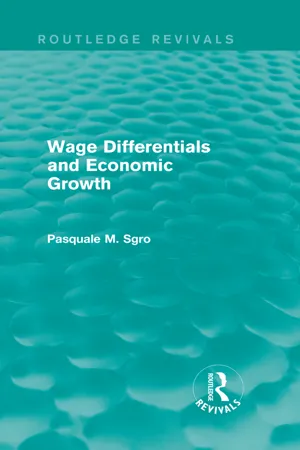Economics
Factor Price Equalization
Factor Price Equalization refers to the tendency for the prices of production factors, such as labor and capital, to equalize across different locations due to international trade and factor mobility. This concept suggests that trade and the movement of factors of production can lead to a convergence in the prices of these factors across countries, ultimately impacting global economic dynamics.
Written by Perlego with AI-assistance
Related key terms
Related key terms
1 of 4
Related key terms
1 of 3
11 Key excerpts on "Factor Price Equalization"
- eBook - ePub
- Daron Acemoglu(Author)
- 2008(Publication Date)
- Princeton University Press(Publisher)
j s are equalized.In this model, conditional Factor Price Equalization is a consequence of free and costless trade in goods, since each factor is used only in the production of a single traded intermediate. Nevertheless (conditional) Factor Price Equalization results are more general than the specific structure here might suggest. In the jargon of international trade theory, with free trade of commodities, there exists a cone of diversification such that when factor proportions of different countries are within this cone, there will be (conditional) Factor Price Equalization. The assumptions here that labor is used in the production of the labor-intensive intermediate and capital is used in the production of the capital-intensive intermediate (and that international trade is costless) ensure that the cone of diversification is large enough to include any possible configuration of the distribution of capital and labor stocks across countries.Conditional Factor Price Equalization is important because it implies that factor prices in each country are entirely independent of its capital stock and labor (provided that the country in question is small relative to the rest of the world; recall footnote 1 in the previous chapter). The distinguishing feature of the model in this section is this independence of factor prices from accumulation decisions.3Because capital again depreciates at the rate δ , the interest rate in country j at time t isLet us next specify the resource constraint. While there is free international trade in commodities, there is no intertemporal trade. Thus we are abstracting from international lending and borrowing discussed in the previous two sections. This enables us to isolate the effects of international trade in the simplest possible way. Lack of international lending and borrowing implies that at every date, each country must run a balanced international trade. Thus the following trade balance equation - eBook - ePub
International Trade
New Patterns of Trade, Production and Investment
- Nigel Grimwade(Author)
- 2020(Publication Date)
- Routledge(Publisher)
factor-price equalisation theorem.Figure 2.9Factor price equalisationConsider two countries, A and B, one capital-abundant (A) and the other labour-abundant (B). Suppose each produces two goods, textiles (T) and steel (S). These are shown in Figure 2.9 . Textiles are labour-intensive while steel is capital-intensive. In the absence of trade relative goods prices and relative factor prices will differ in the two countries. In A, capital will be relatively cheap and labour expensive; in B, labour will be relatively cheap and capital expensive. If PK is the price of capital (the rate of profit) and PL is the price of labour (the wage rate), let P* represent PL PK which is measured on the vertical axis. We can see that, in the absence of trade,. If, now, we move across to the left-hand quadrant of the diagram, we can read off the relative prices of the two goods in each country. Let P stand for the price of textiles relative to the price of steel. Now, because labour is relatively expensive in A, textiles, being a labour-intensive good are relatively more expensive in A, that is, Pa >Pb . Finally, we move across to the right-hand quadrant to determine the the ratio of labour-to-capital in each of the two sectors. Because textiles are labour-intensive and steel capital-intensive, the schedule for textiles lies to the right of that for steel. In A, the labour-capital ratio is As in steel and AT in textiles; in B, because labour is cheaper, the labour-capital ratio is higher in both sectors, Bs in steel and BrP a *>P b * - eBook - ePub
- G.M. Grossman, Kenneth Rogoff(Authors)
- 1997(Publication Date)
- North Holland(Publisher)
Labels are important since they can influence the conversation in important but unfelt ways. For example, when we call trade barriers “protection” and estimators “unbiased”, our critical attitudes can diminish. Likewise when we name a result the “Factor Price Equalization” theorem, it is unsurprising that most of us have the impression that it deals with the international equalization of factor prices. Indeed it does, but only as a corollary. A more accurate name for conveying the true meaning of the result would be the Factor Price Insensitivity theorem, which contrasts in important ways with FPE.Factor Price Insensitivity theorem (FPI): Within a country, factor prices are altogether insensitive to changes in factor supplies, holding product prices fixed.Factor Price Equalization theorem (FPE): Factor prices are the same in different countries.Another way of stating the Factor Price Insensitivity theorem is that the demand for labor in an open economy is infinitely elastic. This requires that factor supply variation is too small to take the country into a different cone of specialization. Factor Price Equalization is a corollary requiring the additional and unlikely trio of assumptions: identical technologies, identical product mixes and no factor intensity reversals.In addition to deflecting our attention away from the empirically more relevant FPI theorem, the traditional way of expressing FPE hides its real message. The message isn't that factor prices are equalized, or even that they are insensitive to variation in factor supplies. The message is the mechanism, namely variation in the mix of output. There might well be other mechanisms to achieve the same results, but both FPE and FPI rely on changes in the composition of output, and these results should be judged to be empirically invalid if there is no evidence that the mix of output depends on factor supplies.Furthermore, like any other arbitrage condition, both FPI and FPE are conditions that necessarily take some time to hold, if they hold at all. Although the theories make no explicit reference to time, we all understand what is really being asserted: arbitrage works rapidly enough so that in the vast vibrating real economy we can “see” the force of arbitrage at work. - E. Grinols(Author)
- 2013(Publication Date)
- Taylor & Francis(Publisher)
let condition a or b hold. Then Factor Price Equalization occurs for countries A and B if the value of their state dependent marginal products lie in the space spanned by the returns of internationally traded securities.Proof Let sk = (sk (l), . . ., sk (α), . . ., sk (S)) ∊ Rs be the return to a traded security, Then pj (α)fn j = Σ k ajk sk and Pj (α)(fj – kj f’j ) = Σ k bjk sk , j = 1, for some coefficients ajk (k1 ), bjk (k2 ) by hypothesis of spanning.If follows thatand system (4.10) is identical for all trading countries producing goods 1 and 2. Condition (a) or (b) implies the system is globally univalent, hence k1 ,k2 are equal across countries. Since marginal products depend only on k1 k2 lemma 4.1 gives the result.COROLLARY 4.3 (Factor Price Equalization) Assume international trade in securities and condition (a) or (b) holds for each trading country. If markets are complete or production uncertainty is multiplicative, then Factor Price Equalization occurs.Proof Both results follow from Proposition 4.3 . In the former case markets are complete so marginal products must lie in the space spanned by traded securities. In the latter case, fj (kj , α) = ϕ (α)hj (kj ), h’j > 0, h”j < 0 for some multiplicative factor, ϕ j (α), implies that f’i = ϕ (a)hj (kj )(h’/hj = (h’J /hj )fj is spanned by itself.Notice that Proposition 4.3 does not assert that Factor Price Equalization will generally occur (in fact it generally will not) but only gives conditions under which it will occur. Helpman and Razin [1978] argue, for example, that international trade in securities is the crucial element needed to cause equalization of the factor prices. Proposition 4.3 suggests instead that the important element is not international trade in securities but rather the size of the span of traded security returns relative to the state-dependent factor marginal products. It is possible to have international trade in securities and not have Factor Price Equalization even when condition (a) or (b) for global univalence holds. The reason is that prices βj (α) may differ from country to country even with international trade in securities. Different prices imply a different system (4.10) for each country and hence different factor prices. Only if marginal products happen to lie in the space spanned by returns of internationally traded securities is system (4.10) guaranteed to be the same across countries. In that case, univalence gives the result. To summarize, under uncertainty there are two conditions which must be met for global Factor Price Equalization instead of one condition under certainty. The system (4.10) must be globally univalent (also required under certainty) and the value of the marginal product must be spanned by the return of traded securities (automatically satisfied under certainty) in order for (4.10) to be the same set of equations across countries. Otherwise, cross-country differences in risk prices β j (α) cause (4.10) to represent different equations across countries. Univalence of different (4.10)- eBook - ePub
- R. M. Sundrum(Author)
- 2003(Publication Date)
- Routledge(Publisher)
The Factor Price Equalization tendency of the Heckscher–Ohlin model may still operate even if the technology of production differs in the trading countries. For example, if the technology of production in LDCs is uniformly lower than in the DCs in the sense that the productivity of factors in LDCs is lower than in the DCs by the same proportion in all sectors, then the two types of countries may be assumed to have the same production function when factors are measured in ‘efficiency’ units rather than in ‘natural’ units. The effect of trade will then be to reduce differences in the prices of the factors in efficiency units. If factor prices are equalized in efficiency units, then the prices in natural units will be lower in LDCs by a uniform fraction representing the technical inefficiency of LDCs. But, in fact, the technical inefficiency of factors in LDCs varies according to the sector in which they are employed. Therefore the tendency for factor prices to be equalized will operate to a much smaller extent.(iv) Primary product specialization of LDCsAn important condition for the Factor Price Equalization tendency is that a sufficient number of commodities are produced in all trading countries. But the difference in factor endowments and in technology between LDCs and DCs is so great that LDCs came to be highly specialized in primary products and DCs in manufactures. In fact, to the extent that trade between these countries lowers the returns to capital in LDCs and raises them in DCs, and to the extent that the supply of capital responds to these changes, the effect of trade will be to widen the differences in factor endowments of these countries, and hence the tendency towards specialization (Findlay 1970; Stiglitz 1970). When countries are so highly specialized, trade does not have the postulated effect of equalizing commodity prices leading to the equalization of factor prices.The effect of trade was therefore to expand the sectors producing primary products and to limit the sectors producing manufactures. Hence the distribution of income within the agricultural sector came to have greater weight in determining the overall distribution of income, as discussed in the above section.(v) Terms of trade effectWhen commodity prices are not equalized, an important influence on factor prices are the terms of trade between countries. Further, there are significant changes in these terms of trade as a result of technological progress. Most neoclassical analyses of the effects of technological progress on the terms of trade assume that the same commodities are produced in all trading countries but in different proportions. But when countries are highly specialized in the commodities they produce, a more relevant model is that of Lewis (1954, 1969, 1978) which assumes that some of the traded commodities are highly specific to particular countries. Lewis has argued that the wages of labour in each country are determined by its productivity in the commodities produced in both countries, typically food. Then, technical progress in food production will raise wages, while technical progress in the specific commodity exported by the country will only reduce its price without affecting wages. - eBook - ePub
International Economics
A Heterodox Approach
- Hendrik Van den Berg(Author)
- 2016(Publication Date)
- Routledge(Publisher)
In terms of the model presented above, free trade will make the price of clothing the same in both Here and There. Similarly, the price of food will end up the same in each country. Then, we also assume that markets are perfectly competitive, so that the price of final goods is exactly equal to the costs of the resources used to produce them. We further assume that technology and production methods are the same in both countries, so that the production functions of the clothing industries in Here and There are the same, as are the production functions of the food industries in both Here and There. In this case, identical product prices translate into identical factor prices. Therefore, with completely free trade, perfect competition, no transport costs, and the other assumptions of the HO model, workers earn the same wage regardless of which country they work in. Similarly, the return to capital is the same everywhere. This result is formally known as the Factor Price Equalization theorem. The Factor Price Equalization theorem seems to verify rich-country workers’ worst fear, which is that free trade will drive wages down to the levels of sweatshops in Bangladesh and India. That interpretation is not quite correct, of course. The theorem also suggests that free trade will raise the wages of poor Indian workers closer to current American workers’ wages. The model suggests that all workers’ wages will end up somewhere between the world’s highest and the world’s lowest wages. Even this prospect is not comforting for workers in high-wage countries. Interestingly, those who use the HO model to justify free trade often reject the Factor Price Equalization theorem as unrealistic, especially when they face criticism of free trade by worker groups in high-income countries - Wilhelm Kohler(Author)
- 2014(Publication Date)
- WSPC(Publisher)
5 Venables (1999) demonstrates that even in a single two-sector model several different outcomes may arise, including “some curious cases.” Using a somewhat more general framework, Jones and Kierzkowski (2001a, 2001b) discuss a host of different outcomes — “some rather surprising” — where fragmentation may be beneficial or harmful to low-skilled workers in relation to skilled workers or capital, depending on a complex interplay between the factor endowment position and output pattern of a country on the one hand, and the details of the fragmented activities on the other. The richness of possible results also extends to the question of international Factor Price Equalization. Thus, Deardorff (2001a) shows that fragmentation increases the likelihood of international Factor Price Equalization in that it renders Factor Price Equalization an equilibrium outcome for certain factor endowments which would otherwise rule this out. However, as shown in Deardorff (2001b), individual instances of fragmentation may well increase international factor price differences.This brief review reveals that the present state of knowledge largely relies on casuistic discussions. What we are still missing is a concise formulation of a general principle which is at force in each special case. This paper suggests a general equilibrium framework which allows us to formulate such a principle. The framework is one where trade is determined by a coexistence of Ricardian and Heckscher–Ohlin-type comparative advantage, allowing for an arbitrary number of goods and factors, and where factor price differences are the driving force of fragmentation. According to conventional theory of comparative advantage, a production process is carried out under a single set of factor prices, domestic or foreign. The distinctive feature of international, as opposed to domestic, outsourcing is that it allows production of a single good, or a single value-added process, to draw on different factor markets with differing factor prices. Domestic outsourcing is, almost by definition, outsourcing to a market with the same factor prices. In contrast, international- eBook - ePub
General Equilibrium Analysis
A Micro-Economic Text
- Harry G. Johnson(Author)
- 2017(Publication Date)
- Routledge(Publisher)
Y , implying in the two-factor model that labour is an abundant factor at that point, exporting labour and importing capital can be conceptualized as negative production of the capital-intensive good and increased positive production of the labour-intensive good past the point of complete specialization, since according to the Stolper-Samuelson relation this change in outputs creates an excess supply of capital and excess demand for labour at constant factor prices. The consequent fall in the absolute (and relative) price and marginal product of capital and rise in the absolute (and relative) price and marginal product of labour implies that factor movement will provide factor-price equalization.FIGURE 2.8The factor owner production block approach to the theory of income distribution is illustrated in Figure 2.8 , a further variant of the Lerner-Pearce diagram. The production function of each good again is represented by a single isoquant, and XX and YY going through the factor endowment point E represent the maximum amounts of X and F that the economy is capable of producing with its given technology and factor endowment. Points I and I represent the endowment points of each factor owner which by the principles of vector addition must add up to E if it is assumed that all factors are fully employed. Complete specialization on X implied factor prices equal to the slope of the X -isoquant at point E and the factor utilization ratio OR in X , to which there is a corresponding point of equal slope on the F-isoquant indicating the implicit factor utilization ratio in F when production of F is zero, and given in the diagram asORyo. Similarly, complete product specialization on good F implies a factor price ratio equal to the slope of the Y -isoquant at E and the factor utilization ratio OR in F, to which there is a corresponding point of equal slope on the X -isoquant indicating the implicit factor utilization ratio in X when production of X is zero, and represented in the diagram asORXO.Given the optimal factor utilization ratios in the two industries when production is specialized, it is possible to determine the allocation of the resources of each factor owner between the two commodities on the dual assumptions of domestic factor mobility and that the factor quantities used in the two industries by each individual add up to his total factor endowment. These allocations are determined on the principles of vector addition by completing the parallelogram formed by the endowment point of each factor owner and the optimal factor utilization ratios in the two industries, in the separate cases of complete specialization on each commodity. When there is complete specialization on good X , OR andORyoare the relevant factor utilization ratios, in which case owner I ’s factor allocations are shown byIx, andIy, indicating positive production of X and negative production of Y , while II ’s factor allocations are shown byIIXandIIy, indicating positive production of both goods, II ’s positive production of Y must, of course, offset I ’s negative production of this good if the economy is completely specialized on X . OR andORxoare the relevant factor utilization ratios where there is complete specialization on good Y , in which case I ’s factor allocations are given byIx′ andIy′ indicating positive production of both goods, while TV’s factor allocations are shown byIIX′ andIIy′ indicating positive production of Y and negative production of X - Bharat Hazari(Author)
- 2016(Publication Date)
- Routledge(Publisher)
Part One THE THEORY OF FACTOR PRICE DIFFERENTIALS AND THE PURE THEORY OF INTERNATIONAL TRADEPassage contains an image
2 FACTOR PRICE DIFFERENTIALS, THE SHAPE OF THE TRANSFORMATION LOCUS AND THE RELATIONSHIP BETWEEN PRICES AND OUTPUT LEVELS This part of the book (Chapters 2 –5 ) deals with some aspects of the theory of international trade under the assumption that the factor markets are imperfect. The factor market imperfection is assumed to take a specific form, namely that a qualitatively identical factor earns a higher reward in one sector of the economy compared with its reward in the other sector of the same economy.1 This type of factor price differential is regarded as distortionary and is distinguished from factor price differentials that need not be distortionary.2 For example, an observed wage differential between the rural and urban sector does not represent a genuine distortion if it is caused by, say, a utility preference between occupations on the part of the wage-earners. A factor price differential is considered to be distortionary when it cannot be explained on legitimate economic grounds. Various reasons may be advanced for the presence of a distortionary factor price differential. The reasons typically given in the literature are, for instance, differential factor taxation (Harberger (3)); or trade union intervention and the existence of the wage differential between the industrial and the subsistence sector of an underdeveloped economy.3 It is important to note that the distortionary factor price differential is assumed to exist in spite of the assumption of perfect factor mobility between sectors.In this chapter the standard model of trade presented earlier is extended to include the presence of a factor price differential. Since there are two factors of production in the model, capital (K) and labour (L), there are two markets in which factor price differentials can be introduced. However, to keep the exposition simple, we only introduce factor price differential in one market. We introduce an exogenous distortion in the labour market in which it is assumed that the qualitatively identical factor, labour, does not earn the same reward in both sectors of the economy. Given the presence of this exogenous distortion several issues are examined in this chapter, for instance, the relationship between commodity prices and factor prices, the impact of the distortion on the shape of the production possibility locus and the relation between changes in commodity prices and levels of output.- Mark Baimbridge, Philip Whyman(Authors)
- 2005(Publication Date)
- Routledge(Publisher)
Source: Commonwealth Budget Paper No. 3, ‘Federal Financial Relations, 2000–01’. Notes Total is equal to $23,955.6 million from the Goods and Services Tax in 2000–01 and $6,092.1 in Health Care Grants which are also subject to the equalization formula.Criticism of the equalization system has been directed at its efficiency costs. For example, Gramlich (1984) has been highly critical of the equalization model on efficiency grounds, claiming that it encourages people and capital to migrate to remote areas that are costly to supply. Dixon et al. (1993) use a general equilibrium model to argue that equalization leads to inefficient inter-State migration of capital and labour. Albon (1990) makes similar criticisms.The system can also be defended on efficiency grounds. An obvious way to do this is to draw on the well known notion that inter-State transfers may be required to establish an efficient allocation of mobile factors of production between States. This argument, developed by Boadway and Flatters (1982), and refined by others including Myers (1990), Mansoorian and Myers (1993) and Burbidge and Myers (1994), is that if States have access to taxes on resource rents, or create fiscal externalities from the operation of their tax and expenditure systems, a free migration equilibrium in which factors allocate themselves between States to satisfy some sort of ‘equating at the margin rule’ may be inefficient. For example resource-rich States may use rents to provide location-specific factor subsidies. Inter-State transfers then have the potential to move factors in such a way that creates efficiency in their geographic distribution and maximizes national welfare.Dixon et al. (1993) obtain the result that transfers shift factors inefficiently because they do not allow for the possibility that State taxes on resource rents and fiscal externalities can lead to inefficient free migration of mobile factors. Rather, in their model, factors always allocate themselves efficiently across States in the absence of transfers. Therefore, any inter State transfer induces inefficiency. This feature of the Dixon et al- Pasquale Sgro(Author)
- 2020(Publication Date)
- Routledge(Publisher)
19Having examined the relationship between the pattern of specialization and relative factor endowments, we will now proceed to analyze the affect on the world equilibrium price ratio of a change in relative factor endowments. This will then give us sufficient information to examine how trade affects the path of capital accumulation in each country.Figure 5.5.25.6Factor Endowments and the Terms of TradeThe effects of a change in relative factor endowments upon the world equilibrium price of the investment good can be found by examining equation (5.4.2) .Differentiating equation (5.4.2) with respect to kα and kβ yields the following expressions:d P / d(5.6.1)k α= −[/]q α⋅∂v α∂k α[]q α⋅+∂v α∞ Pq β⋅∂v β∂ Pd P / d(5.6.2)k β= −[/]q β⋅∂v β∂k β[.]q α⋅+∂v α∂ Pq β⋅∂v β∂ PAs we can see from equations (5.6.1) and (5.6.2 ), the effects of a change in relative factor endowments on the equilibrium price ratio depend on change in each country’s factor endowments as well as the combined price effects on the excess demand functions of each country.Given our assumption on the factor intensity ranking (5.5.1 ),and the relations (5.5.5 )–(5.5.7 ), the sign ofand∂v α∂k αin (5.6.1 ) and (5.6.2 ) can be determined for various patterns of specialization. In the case of no physical factor intensity reversal, the sign of∂v α∂k βand∂v α∂ Pin (5.6.1 ) and (5.6.2 ) is zero or negative.20∂v β∂ PEquations (5.6.1) and (5.6.2 ), along with (5.3.22 ), (5.5.1 ) and (5.5.5 )–(5.5.7 ), yield the following results on specialization patterns which are summarized in Table 5.1 below. Recall that good one is the consumption good (C) while good two is the investment good (I).Table 5.1: Production Pattern, Factor Endowments and the Terms of Trade when k
Index pages curate the most relevant extracts from our library of academic textbooks. They’ve been created using an in-house natural language model (NLM), each adding context and meaning to key research topics.
Explore more topic indexes
Explore more topic indexes
1 of 6
Explore more topic indexes
1 of 4
